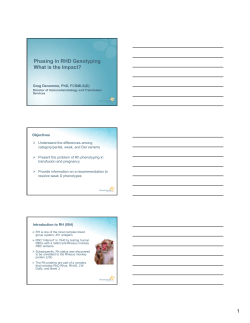
PBM newsletter 4v 2- O neg .pub
Patient Blood Management Number 4 v 2 : May 2015 NHSBT Patient Blood Management Newsletter Welcome This is the fourth edition of the Patient Blood Managem ent newsletter produced by the NHSBT Patient Blood Management Team. Th is e d itio n o f o u r n e w s le tte r fo cu s e s o n th e ap pro priate u s e o f Gro u p O Rh D N e ga tive Re d Ce lls . The PBM team prom ote appropriate use of all blood com ponents and their alternatives across England and North Wales, by providing educational resources, support and information. Read more: Patient Blood Management An evidence based approach to patient care http://www.transfusionguidelines.org.uk/uk-transfusion-committees/national-blood-transfusion-committee/patient-blood-management Why is Group O RhD negative so important? Group O red cells are the only blood group that can be given w h e n t h e p a t ie n t s b lo o d g r o u p is u n k n o w n o r n o t im m e d iately available. As a consequence of this there is a higher demand from hospitals for stocks of this blood group. Only 11% of our donors have the blood group O RhD negative and they can only donate blood a maximum of four times per year if male and three times per year if female. This means that we need to think carefully about why and when we are using this limited and precious resource. Read more: http://www.blood.co.uk/about-blood/blood-group-basics/ There are several indications for appropriate and necessary use of Group O RhD negative red cells, these include: Group O RhD negative neonates and children Group O RhD negative patients with anti D Group O RhD negative females of childbearing potential Females of childbearing potential whose blood group is unknown (usually emergency scenarios) Intrauterine transfusions (except in cases where the mother has particular antibodies) Patients who need matched blood when the only compatible blood available is O RhD negative. Read more: http://hospital.blood.co.uk/media/27426/nbtc-2009-o-neg-recommendations.pdf D id yo u kn o w ? On average each O RhD negative blood donor donates 20% more blood than other donor groups Choosing wisely To help ensure that group O RhD negative blood is always available for those patients who really need it: Switch to type specific red blood cells as soon as it becomes available - contact the transfusion laboratory to ensure they have received a crossmatched blood sam ple or if they have a previous record of the patient s blood group. Consider using O RhD positive blood instead of O RhD negative blood - it is important not to transfuse children and women of childbearing potential with cells carrying the RhD antigen, but adult males and older adult females could receive O RhD positive blood instead of O RhD negative. Find out what the policy is in your hospital To have and to hold Maintaining unnecessarily high O RhD negative red cell stocks in hospitals places a strain on the supply of this group and on the O RhD negative donors who help support it. Wastage of O RhD negative red cells is higher than any other blood group. From J anuary 20 14 December 2014, 8,555 units of group O RhD negative red cells were wasted in England and North Wales. Common reasons for wastage are: The unit reaches its expiry date Out of temperature control: following delivery to the clinical area it has been decided not to transfuse the unit but the unit has been out of the fridge for too long and cannot be reused If you are not going to use the unit immediately it will need to be returned to the laboratory within 30 minutes Regularly review when and why you used O RhD negative red cells for emergencies and investigate incidents where its use is considered inappropriate There are free educational resources to support appropriate use of O RhD negative red cells http://hospital.blood.co.uk/ And search for O RhD Neg Resources A recent national survey In 2014 the National Transfusion Laboratory Managers Group found that: 66% of hospitals O RhD neg stock was above the recom m ended maxim um 10 .5% of total stock 42% of hospitals didn t have a policy for transfusing O RhD positive blood to adult males of unknown blood group Only 59% of hospitals could switch to group specific red cells by 15 minutes However, on a more positive note: 66% always investigated when more than 2 units of O RhD negative unit were used in emergency 81% have a lab stock holding policy to transfuse O RhD negative blood to non-O RhD negative patients The report makes a number of recommendations to promote good practice. Read more: http://www.transfusionguidelines.org/uk-transfusion-committees/national-blood-transfusion-committee/working-groups For further information please contact: Follow us on Twitter for national and regional news and updates NHSBT.customerservice@ nhsbt.nhs.uk @PBM_NHS 01865 381038 @SEC_RTC Also visit the website: @NW_RTC http://hospital.blood.co.uk/ Dates for your diary 21 -25 July: RCN Congress in Bournemouth http://www.rcn.org.uk/newsevents/congress/2015 @london_rtc @EoE_RTC 27 June 1 July: 25th Regional Congress of the ISBT in conjunction with the 33rd Annual Conference of the British Transfusion Society, London www.isbtweb.org/events-congress
© Copyright 2024











